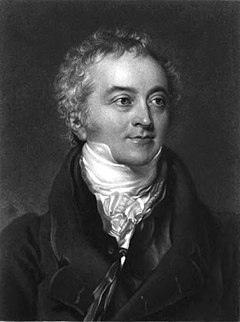Thomas Young
Thomas Young | |
|---|---|
 | |
| Kelahiran | (1773-06-13)13 Jun 1773 Milverton, Somerset, England |
| Meninggal dunia | 10 Mei 1829(1829-05-10) (umur 55) London, England |
| Pusat pendidikan | Sekolah Perubatan Universiti Edinburgh Universiti Göttingen Kolej Emmanuel, Cambridge |
| Terkenal kerana | Teori gelombang cahaya Eksperimen dwicelah Young Astigmatisme Teori Young–Helmholtz Modulus Young |
| Kerjaya saintifik | |
| Bidang | Fizik Fisiologi Egiptologi |
| Tandatangan | |
 | |
Thomas Young FRS (13 Jun 1773 - 10 Mei 1829) ialah seorang ahli polimat dan doktor Inggeris.[1] Young membuat sumbangan saintifik yang ketara kepada bidang visi, cahaya, mekanik pepejal, tenaga, fisiologi, bahasa, harmoni muzik, dan Egiptologi. Beliau "membuat beberapa inovasi asal dan berwawasan" dalam penjelasan hieroglif Mesir (khususnya Batu Rosetta) sebelum Jean-François Champollion akhirnya berkembang dalam karyanya. Beliau telah disebutkan, antaranya, William Herschel, Hermann von Helmholtz, James Clerk Maxwell, dan Albert Einstein. Young telah digambarkan sebagai "Manusia terakhir yang mengetahui segalanya".[2]
Rujukan
Bacaan lanjut
- Adkins, Lesley; Adkins, Roy (2000). The Keys of Egypt: The Obsession to Decipher Egyptian Hieroglyphs. Harper Collins Publishers. ISBN 978-0-06-019439-0.CS1 maint: ref=harv (link)
- Barr, E. Scott (1963). "Men and Milestones in Optics. II. Thomas Young". Applied Optics. 2 (6): 639–647. Bibcode:1963ApOpt...2..639B. doi:10.1364/AO.2.000639.- The link is to a pdf version of the paper.
- Robinson, Andrew (2005). "A Polymath's Dilemma". Nature. 438 (7066): 291. Bibcode:2005Natur.438..291R. doi:10.1038/438291a. PMID 16292291.
- Robinson, Andrew (April 2006). "Thomas Young: The Man Who Knew Everything". History Today. 56: 53–57.
- Robinson, Andrew (2006). The Last Man Who Knew Everything: Thomas Young, the Anonymous Polymath Who Proved Newton Wrong, Explained How We See, Cured the Sick and Deciphered the Rosetta Stone. New York: Pi Press. ISBN 978-0-13-134304-7.
- Reviewed[pautan mati kekal] by Nicholas Shakespeare in The Telegraph Diarkibkan 2019-12-25 di Wayback Machine, 24 September 2006.
- Reviewed by Michael Bywater in The New Statesman, 13 November 2006.
- Reviewed Diarkibkan 2006-12-28 di Wayback Machine by Simon Singh in The Telegraph Diarkibkan 2019-12-25 di Wayback Machine, 26 November 2006.
- Reviewed by Rosemary Hill in The Times, 10 December 2006.
- Reviewed by PD Smith in The Guardian, 20 January 2007.
- Saslow, Wayne (2002). Electricity, Magnetism, and Light. Toronton: Thomson Learning. ISBN 978-0-12-619455-5.- Discusses Young's theoretical and experimental work on interference
- Thomasson, Fredrik (2013). The Life of J. D. Åkerblad: Egyptian Decipherment and Orientalism in Revolutionary Times. BRILL.CS1 maint: ref=harv (link)
- Wood, Alex; Oldham, Frank (1954). Thomas Young. Cambridge: Cambridge University Press.
- Young, Thomas (1823). An Account of Some Recent Discoveries in Hieroglyphical Literature and Egyptian Antiquities. London: John Murray. Young's account of his hieroglyphic research. (reissued by Cambridge University Press, 2010. ISBN 978-1-108-01716-9)
Pautan luar
- ABC Radio International program (Ockham's Razor) on Thomas Young – available for download and streaming (as of 9 July 2006)
- Young's 1802 Royal Institution lectures, published 1809, for online or .pdf reading. Available 2 November 2014.








